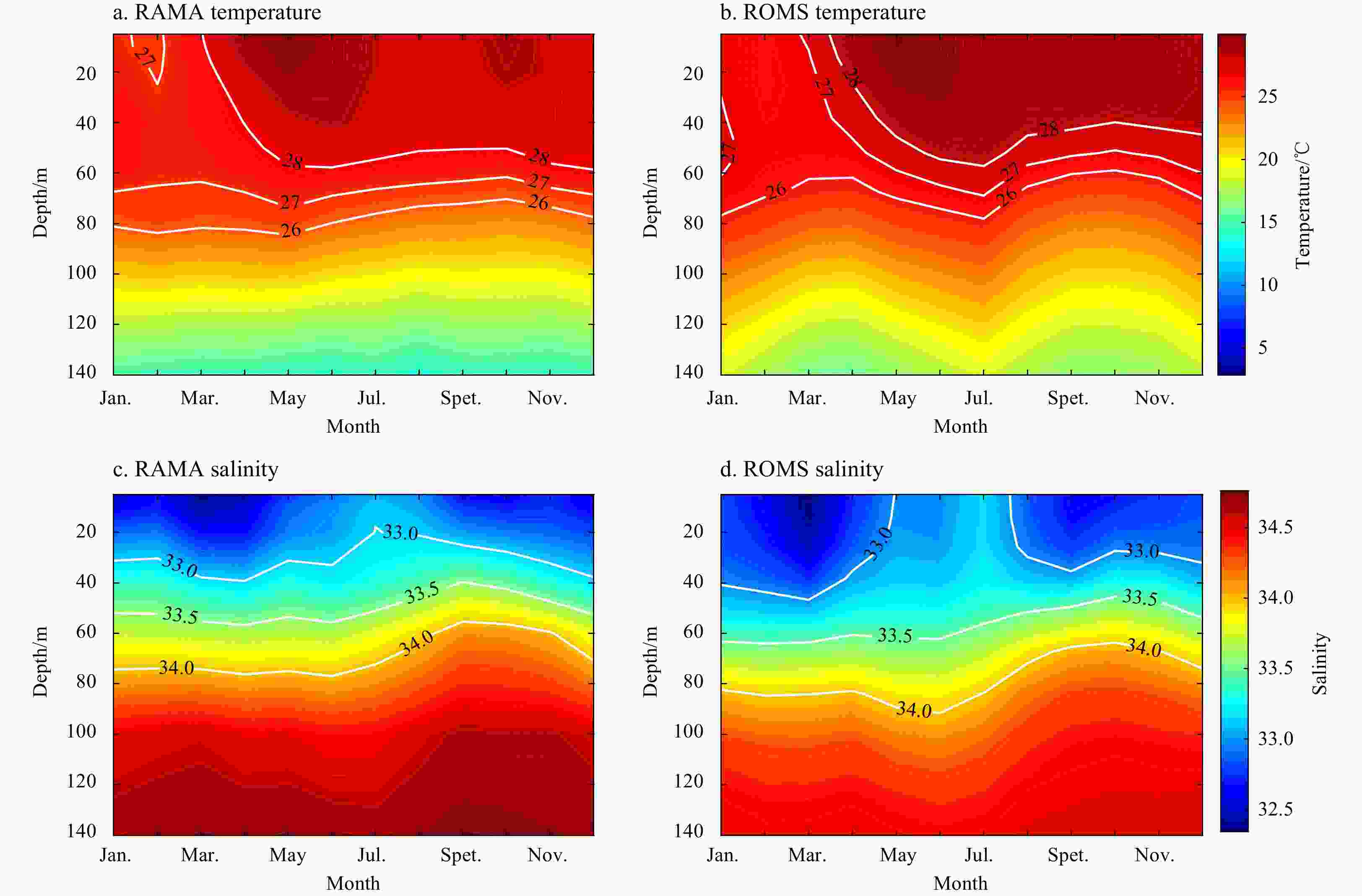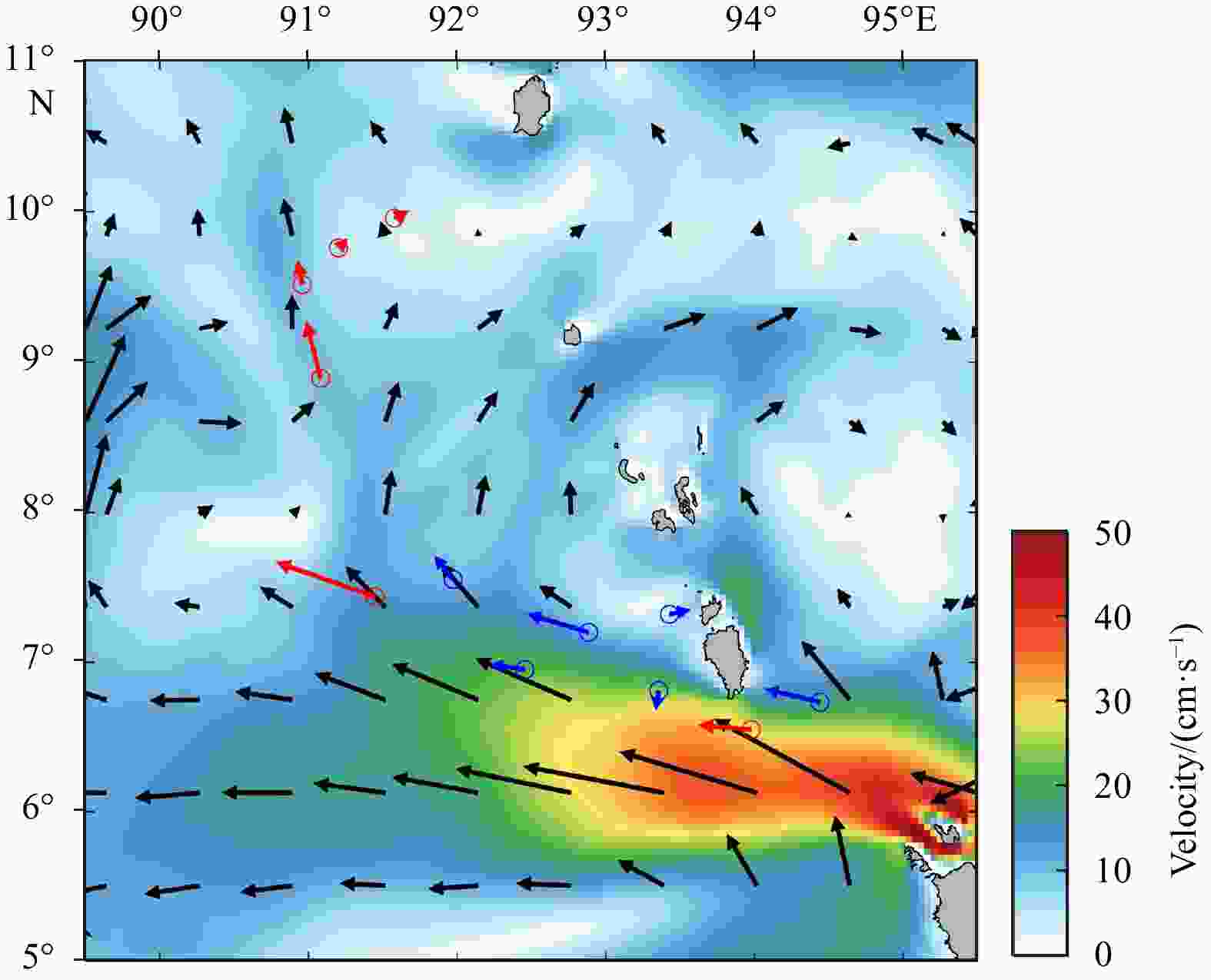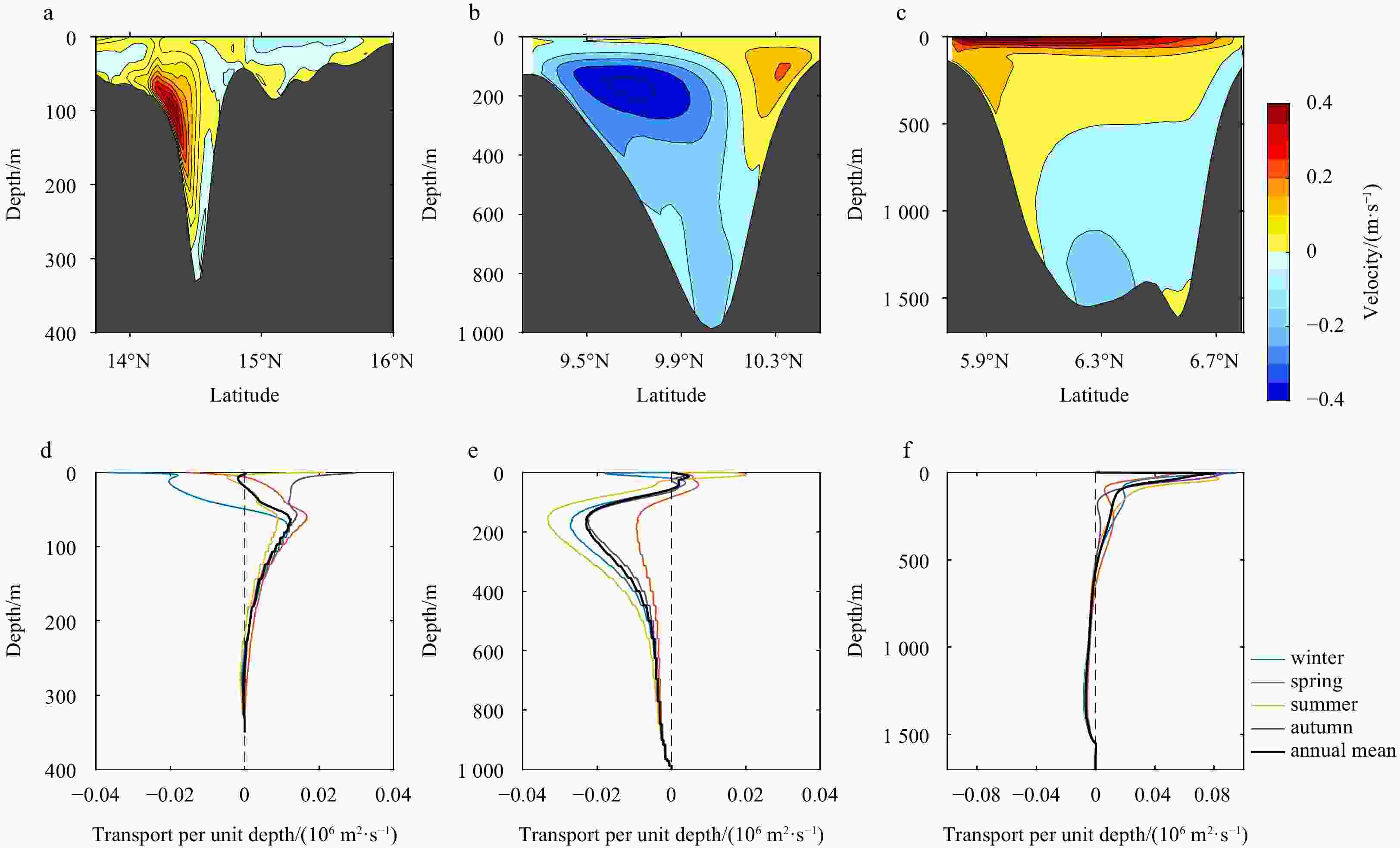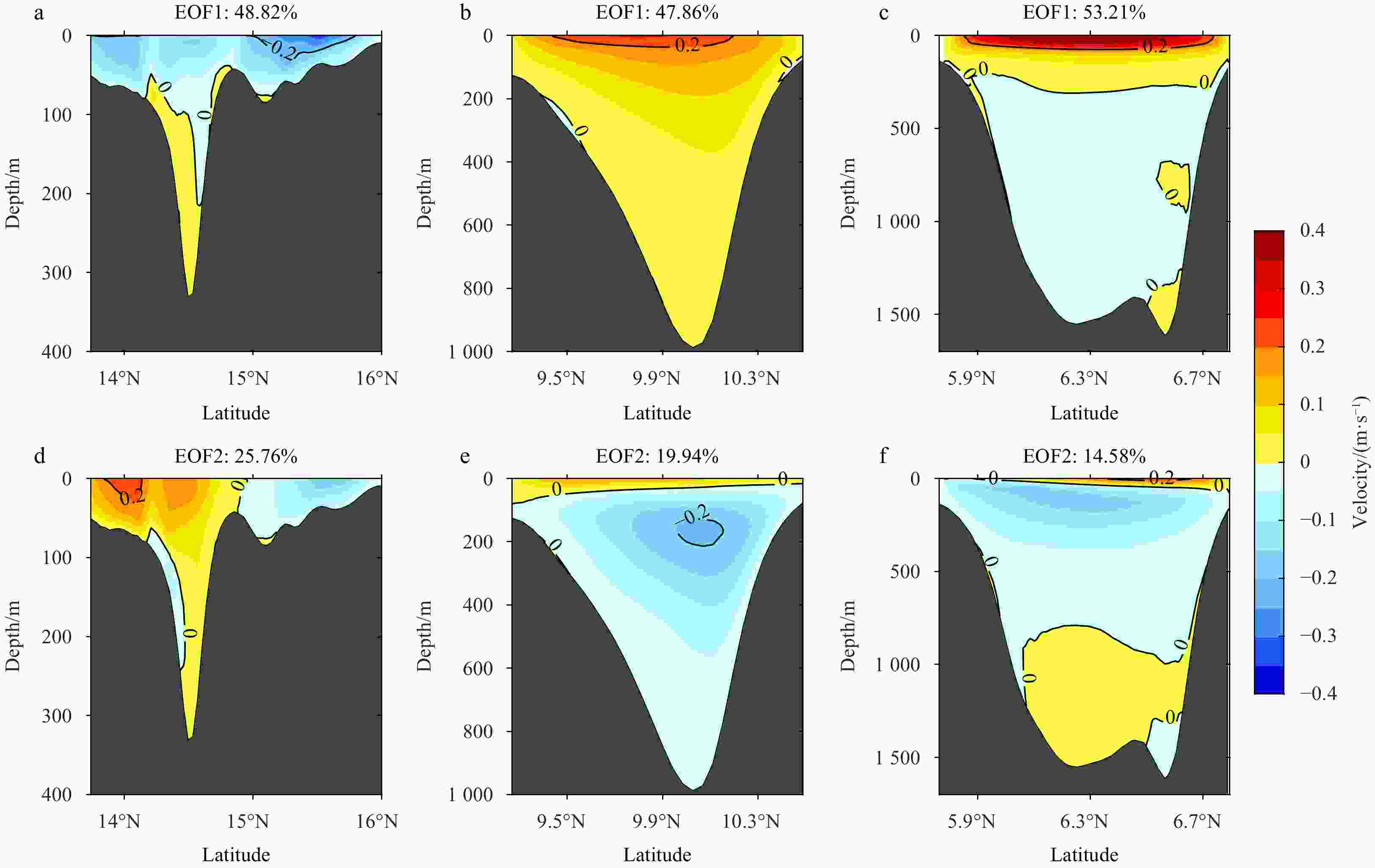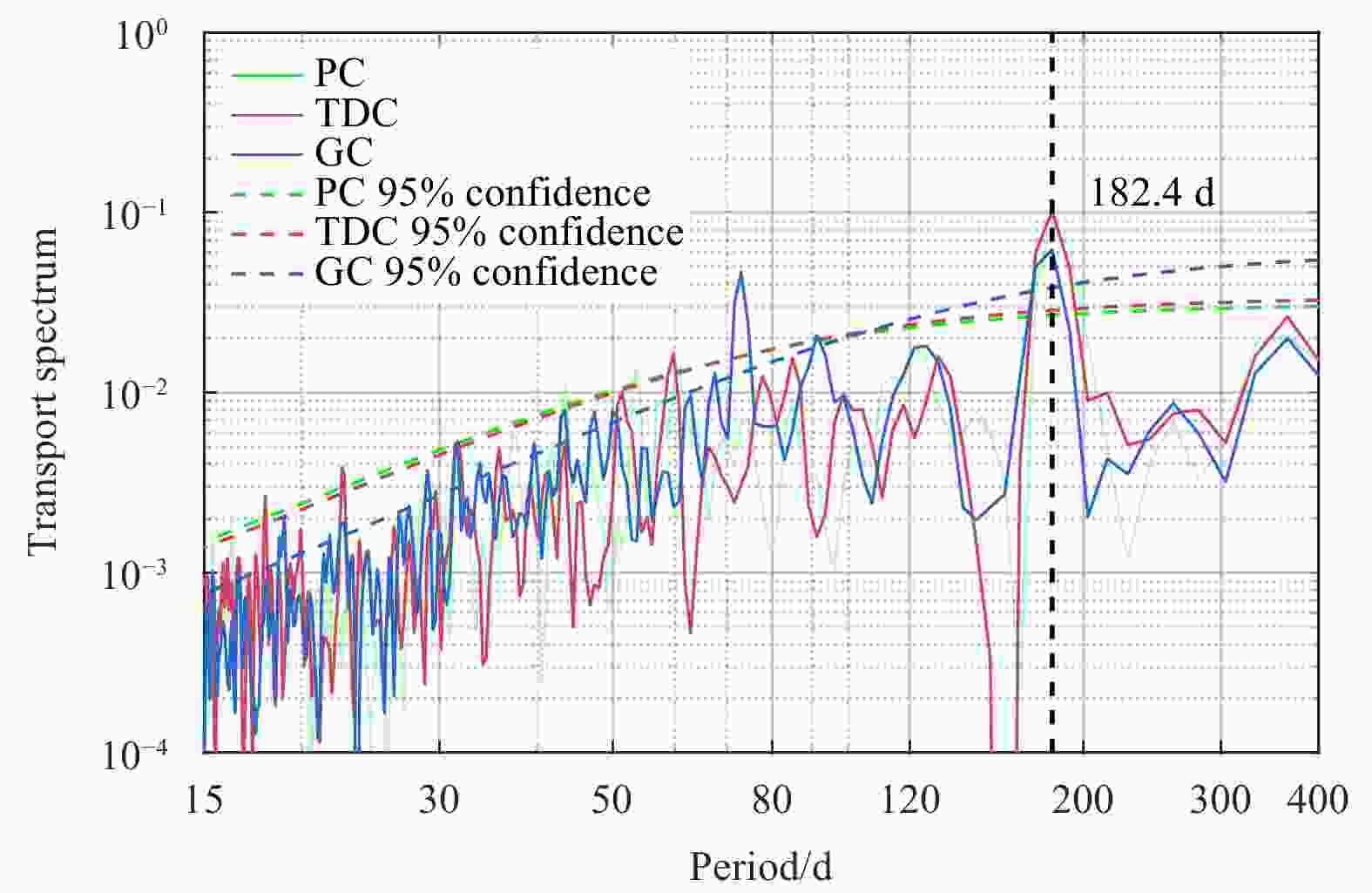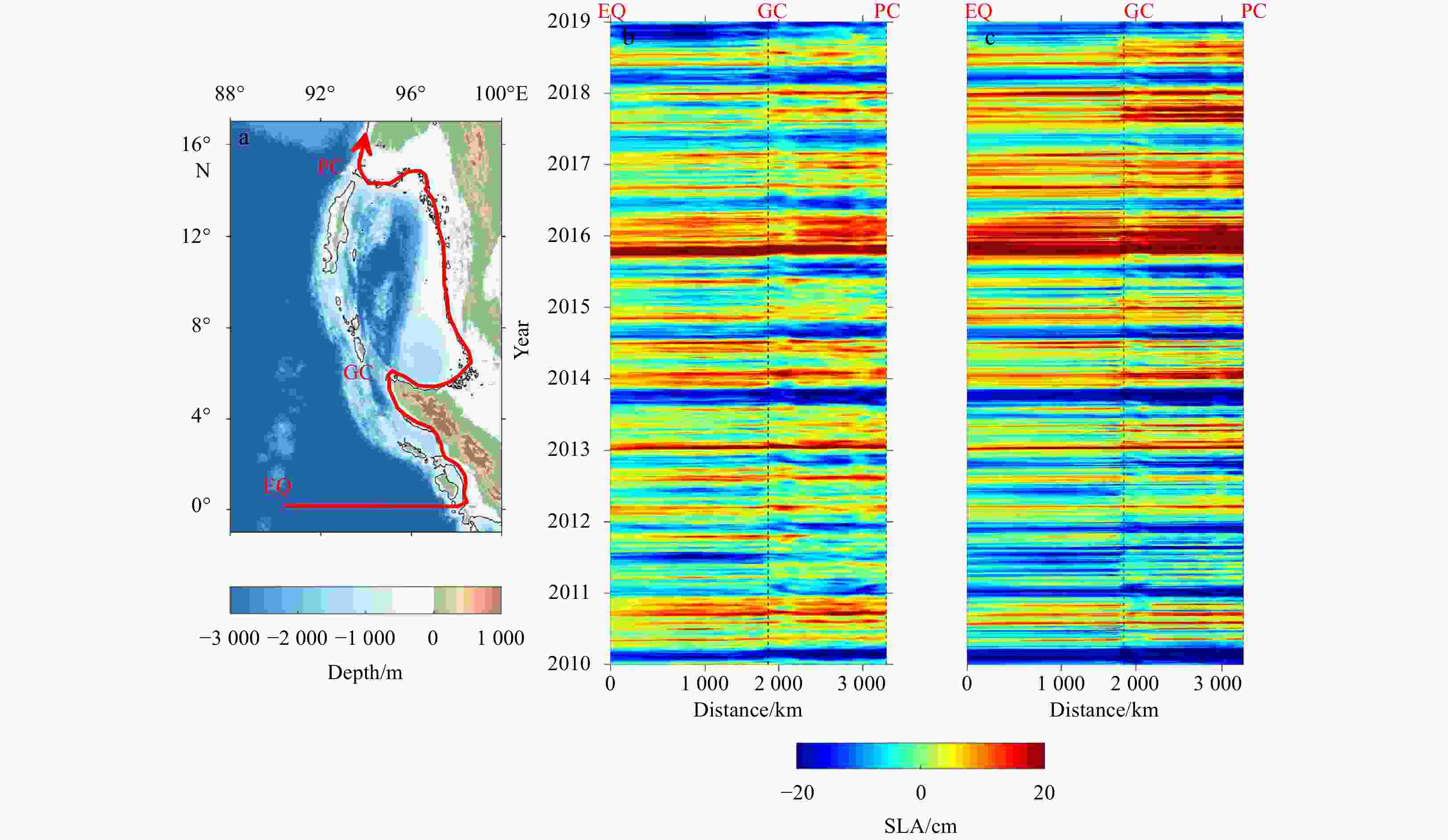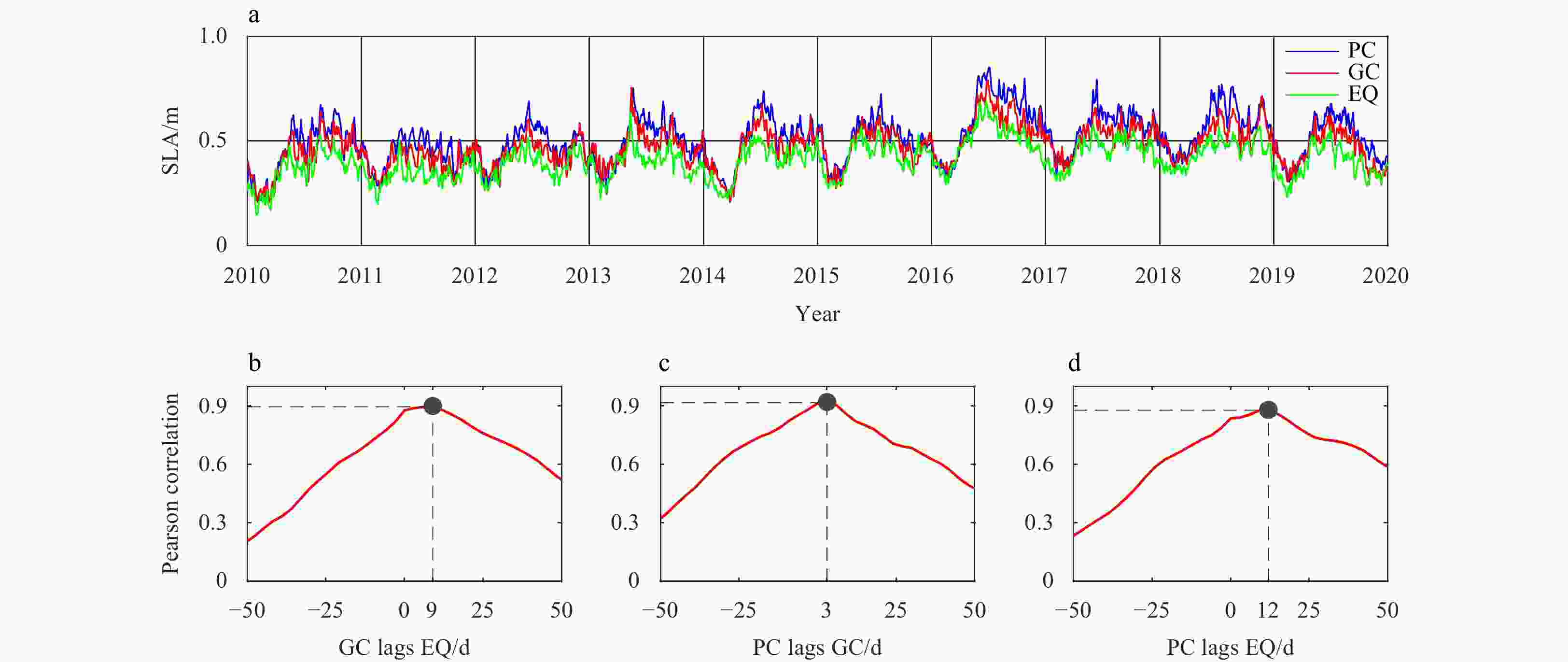Spatiotemporal characteristics of water exchange between the Andaman Sea and the Bay of Bengal
-
Abstract: A high-resolution customized numerical model is used to analyze the water transport in the three major water passages between the Andaman Sea (AS) and the Bay of Bengal, i.e., the Preparis Channel (PC), the Ten Degree Channel (TDC), and the Great Channel (GC), based on the daily averaged simulation results ranging from 2010 to 2019. Spectral analysis and Empirical Orthogonal Function (EOF) methods are employed to investigate the spatiotemporal variability of the water exchange and controlling mechanisms. The results of model simulation indicate that the net average transports of the PC and GC, as well as their linear trend, are opposite to that of the TDC. This indicates that the PC and the GC are the main inflow channels of the AS, while the TDC is the main outflow channel of the AS. The transport variability is most pronounced at surface levels and between 100 m and 200 m depth, likely affected by monsoons and circulation. A 182.4-d semiannual variability is consistently seen in all three channels, which is also evident in their second principal components. Based on sea level anomalies and EOF analysis results, this is primarily due to equatorial winds during the monsoon transition period, causing eastward movement of Kelvin waves along the AS coast, thereby affecting the spatiotemporal characteristics of the flow in the AS. The first EOF of the PC flow field section shows a split at 100 m deep, likely due to topography. The first EOF of the TDC flow field section is steady but has potent seasonal oscillations in its time series. Meanwhile, the first EOF of the GC flow field section indicates a stable surface inflow, probably influenced by the equatorial Indian Ocean’s eastward current.
-
Figure 1. Altimeter of Bay of Bengal (a) and three major passages (b, c, and d). The black solid line represents the 1 800-m isobath, the black dashed lines indicate the three sections used for transport analysis, two red stars mark the mooring sites, the red solid arrows and the blue dashed arrows represent the sea surface circulation patterns during the southwest (SW) monsoon and the northeast (NE) monsoon, respectively.
Figure 2. The climatological monthly variability of temperature and salinity profiles averaged over the RAMA mooring (15°N, 90°E) during 2010–2019, based on RAMA (a and c) and ROMS (b and d). RAMA, Research Moored Array for African-Asian-Australian Monsoon Analysis and Prediction; ROMS, Regional Ocean Modeling System model.
Figure 3. The climatological monthly variability of zonal (u) and meridional (v) velocities profiles averaged over the RAMA mooring (0°, 90°E) during 2010–2019, based on RAMA (a and c) and ROMS (b and d). RAMA, Research Moored Array for African-Asian-Australian Monsoon Analysis and Prediction; ROMS, Regional Ocean Modeling System model.
Figure 4. The climatological seasonal surface flow (color shaded for current speed (cm/s), arrows for current direction) in winter (a, e), spring (b, f), summer (c, g), and autumn (d, h) in the Andaman Sea during 2010–2019, extracted from the OSCAR (a–d) data and ROMS (e–h), respectively. OSCAR, Ocean Surface Current Analysis-Real Time product; ROMS, Regional Ocean Modeling System model.
Figure 9. The first principal component (PC1), the second principal component (PC2) time series and their power spectrum corresponding to the Preparis Channel (a, d, and g), the Ten Degree Channel (b, e, and h), and the Great Channel (c, f, and i). The red and blue lines indicates the 95% confidence interval.
Figure 10. Schematic of the transports through various channels in the Andaman Sea. The red straight-edged rectangles represent the exchange of seawater through the channels, the red rounded rectangles represent freshwater runoff input, and the black dashed lines represent the cross sections used for calculations. Negative values represent westward transport, and positive values represent eastward transport, with units in 106 m3/s.
Figure 11. Time series and trends of transport in the Preparis Channel (a), the Ten Degree Channel (b), and the Great Channel (c) based on Regional Ocean Modeling Systems model output. The dashed lines represent the average value of the channel transport, the dotted lines represent the linear trend of the channel transport, the thin gray lines and thick black lines indicate the 15-d low-passed filtered time series and 120-d low-passed filtered time series. Positive (negative) transport means that water flows into (out of) the Andaman Sea. The gray-blue shades indicate the inflow into the Andaman Sea, while the orange shades signify the outflow. The upper right of the graph is the average net transport, and the lower right is the regression coefficient of the transport.
Figure 14. Selected kelvin waves path along the 100-m depth contour of the Bay of Bengal (a), time-longitude plots of sea level anomaly (SLA) from Sea Level Thematic Assembly Centre (b), and Regional Ocean Modeling Systems model output (c). EQ, equator at 90°E; PC, Preparis Channel; GC, Great Channel.
Table 1. The average transport and standard deviation for the three main channels (the Preparis Channel (PC), the Ten Degree Channel (TDC), and the Great Channel (GC)) during winter, spring, summer, autumn, southwest monsoon (SW), northeast monsoon (NE), and annual
Channel Average transport and standard deviation/(106 m3·s–1) Winter Spring Summer Autumn SW NE Annual PC 0.83 ± 0.86 1.49 ± 1.00 1.22 ± 1.11 1.01 ± 1.02 0.78 ± 0.84 0.44 ± 1.08 1.14 ± 0.43 TDC –8.14 ± 2.90 –9.18 ± 3.00 –9.02 ± 4.13 –7.37 ± 4.96 –10.80 ± 1.40 –8.46 ± 2.45 –8.31 ± 1.26 GC 3.24 ± 3.76 3.78 ± 3.54 3.64 ± 3.26 3.52 ± 1.93 1.34 ± 0.34 0.84 ± 0.46 3.63 ± 1.24 -
Amol P, Jain V, Aparna S G. 2022. Blue-shifted deep ocean currents in the equatorial Indian Ocean. Climate Dynamics, 59(1/2): 219–229, doi: 10.1007/s00382-021-06125-9 Amol P, Shankar D, Fernando V, et al. 2014. Observed intraseasonal and seasonal variability of the West India Coastal Current on the continental slope. Journal of Earth System Science, 123(5): 1045–1074, doi: 10.1007/s12040-014-0449-5 Bonjean F, Lagerloef G S E. 2002. Diagnostic model and analysis of the surface currents in the tropical Pacific Ocean. Journal of Physical Oceanography, 32(10): 2938–2954, doi: 10.1175/1520-0485(2002)032<2938:DMAAOT>2.0.CO;2 Cai Zhongya, Chen Dake, Gan Jianping. 2023. Formation of the layered circulation in South China Sea with the mixing stimulated exchanging current through Luzon Strait. Journal of Geophysical Research: Oceans, 128(3): e2023JC019730, doi: 10.1029/2023JC019730 Chatterjee A, Shankar D, McCreary J P, et al. 2017. Dynamics of Andaman Sea circulation and its role in connecting the equatorial Indian Ocean to the Bay of Bengal. Journal of Geophysical Research: Oceans, 122(4): 3200–3218, doi: 10.1002/2016JC012300 Chen Gengxin. 2022. The ocean wave bridge linking the circulation in the tropical eastern Indian Ocean. Advances in Earth Science (in Chinese), 37(1): 80–86 Chen Guosen, Wang Bin. 2021. Diversity of the boreal summer intraseasonal oscillation. Journal of Geophysical Research: Atmospheres, 126(8): e2020JD034137, doi: 10.1029/2020JD034137 Cheng Xuhua, McCreary J P, Qiu Bo, et al. 2017. Intraseasonal-to-semiannual variability of sea-surface height in the astern, equatorial Indian Ocean and southern Bay of Bengal. Journal of Geophysical Research: Oceans, 122(5): 4051–4067, doi: 10.1002/2016JC012662 Clarke A J, Liu X. 1993. Observations and dynamics of semiannual and annual sea levels near the eastern equatorial Indian Ocean boundary. Journal of Physical Oceanography, 23(2): 386–399, doi: 10.1175/1520-0485(1993)023<0386:OADOSA>2.0.CO;2 Du Ping, Zeng Dingyong, Lin Feilong, et al. 2023. Epipelagic mesozooplankton communities in the northeastern Indian Ocean off Myanmar during the winter monsoon. Acta Oceanologica Sinica, 42(6): 57–69, doi: 10.1007/s13131-022-2090-5 E. U. Copernicus Marine Service Information. 2023. Global ocean gridded L 4 sea surface heights and derived variables reprocessed 1993 ongoing. Marine Data Store (MDS). https://data.marine.copernicus.eu/product/SEALEVEL_GLO_PHY_L4_MY_008_047/description [2023-04-27/2024-01-05], doi: 10.48670/moi-00148 Eigenheer A, Quadfasel D. 2000. Seasonal variability of the Bay of Bengal circulation inferred from TOPEX/Poseidon altimetry. Journal of Geophysical Research: Oceans, 105(C2): 3243–3252, doi: 10.1029/1999JC900291 Evensen G. 2003. The ensemble Kalman filter: theoretical formulation and practical implementation. Ocean Dynamics, 53(4): 343–367, doi: 10.1007/s10236-003-0036-9 Fairall C W, Bradley E F, Hare J E, et al. 2003. Bulk parameterization of air-sea fluxes: Updates and verification for the COARE algorithm. Journal of Climate, 16(4): 571–591, doi: 10.1175/1520-0442(2003)016<0571:BPOASF>2.0.CO;2 Girishkumar M S, Ravichandran M, McPhaden M J, et al. 2011. Intraseasonal variability in barrier layer thickness in the south central Bay of Bengal. Journal of Geophysical Research: Oceans, 116(C3): C03009 Guo Ruoyu, Ma Xiao, Zhang Jingjing et al. 2022. Microbial community structures and important taxa across oxygen gradients in the Andaman Sea and eastern Bay of Bengal epipelagic waters. Frontiers in Microbiology, 13: 1041521, doi: 10.3389/fmicb.2022.1041521 Han Weiqing, Lawrence D M, Webster P J. 2001. Dynamical response of equatorial Indian Ocean to intraseasonal winds: zonal flow. Geophysical Research Letters, 28(22): 4215–4218, doi: 10.1029/2001GL013701 Huang Ke, McPhaden M J, Wang Dongxiao, et al. 2018. Vertical propagation of middepth zonal currents associated with surface wind forcing in the equatorial Indian Ocean. Journal of Geophysical Research: Oceans, 123(10): 7290–7307, doi: 10.1029/2018JC013977 Huang Ting, Zhou Feng, Tian Di, et al. 2020. Seasonal variations of mesoscale eddy in the Bay of Bengal and its adjacent regions. Journal of Marine Sciences, 38(3): 21–30, doi: 10.3969/j.issn.1001-909X.2020.03.003 Iskandar I, McPhaden M J. 2011. Dynamics of wind-forced intraseasonal zonal current variations in the equatorial Indian Ocean. Journal of Geophysical Research: Oceans, 116(C6): C06019 Ji Qiyan, Zhu Xueming, Wang Hui, et al. 2015. Assimilating operational SST and sea ice analysis data into an operational circulation model for the coastal seas of China. Acta Oceanologica Sinica, 34(7): 54–64, doi: 10.1007/s13131-015-0691-y Johnson E S, Bonjean F, Lagerloef G S E, et al. 2007. Validation and error analysis of OSCAR sea surface currents. Journal of Atmospheric and Oceanic Technology, 24(4): 688–701, doi: 10.1175/JTECH1971.1 Kourafalou V H, De Mey P, Le Hénaff M, et al. 2015. Coastal Ocean Forecasting: system integration and evaluation. Journal of Operational Oceanography, 8(S1): s127–s146 Krishnamurti T N, Jana S, Krishnamurti R, et al. 2017. Monsoonal intraseasonal oscillations in the ocean heat content over the surface layers of the Bay of Bengal. Journal of Marine Systems, 167: 19–32, doi: 10.1016/j.jmarsys.2016.11.002 Liao Jiawen, Peng Shiqiu, Wen Xixi. 2020. On the heat budget and water mass exchange in the Andaman Sea. Acta Oceanologica Sinica, 39(7): 32–41, doi: 10.1007/s13131-019-1627-8 Lin Feilong, Liang Chujin, Ding Tao, et al. 2023. A preliminary study of suspended matters variation associated with hypoxia and shoaling internal tides on the continental shelf of the northern Andaman Sea. Journal of Marine Science and Engineering, 11(10): 1950, doi: 10.3390/jmse11101950 McCreary J P Jr, Kundu P K, Molinari R L. 1993. A numerical investigation of dynamics, thermodynamics and mixed-layer processes in the Indian Ocean. Progress in Oceanography, 31(3): 181–244, doi: 10.1016/0079-6611(93)90002-U McPhaden M J. 1982. Variability in the central equatorial Indian Ocean Part I: Ocean dynamics. Journal of Marine Research, 40(1): 157–176 McPhaden M J, Meyers G, Ando K, et al. 2009. RAMA: the research moored array for African–Asian–Australian monsoon analysis and prediction. Bulletin of the American Meteorological Society, 90(4): 459–480, doi: 10.1175/2008BAMS2608.1 Mo Dongxue, Hou Yijun, Li Jian, et al. 2016. Study on the storm surges induced by cold waves in the northern East China Sea. Journal of Marine Systems, 160: 26–39, doi: 10.1016/j.jmarsys.2016.04.002 Mukherjee A, Shankar D, Fernando V, et al. 2014. Observed seasonal and intraseasonal variability of the East India Coastal Current on the continental slope. Journal of Earth System Science, 123(6): 1197–1232, doi: 10.1007/s12040-014-0471-7 Nagura M, McPhaden M J. 2012. The dynamics of wind-driven intraseasonal variability in the equatorial Indian Ocean. Journal of Geophysical Research: Oceans, 117(C2): C02001 Pargaonkar S M, Vinayachandran P N. 2022. The Irrawaddy river jet in the Andaman Sea during the summer monsoon. Frontiers in Marine Science, 9: 849179, doi: 10.3389/fmars.2022.849179 Pujiana K, McPhaden M J. 2020. Intraseasonal Kelvin waves in the equatorial Indian Ocean and their propagation into the Indonesian seas. Journal of Geophysical Research: Oceans, 125(5): e2019JC015839, doi: 10.1029/2019JC015839 Rao R R, Kumar M S G, Ravichandran M, et al. 2010. Interannual variability of Kelvin wave propagation in the wave guides of the equatorial Indian Ocean, the coastal Bay of Bengal and the southeastern Arabian Sea during 1993–2006. Deep Sea Research Part I: Oceanographic Research Papers, 57(1): 1–13, doi: 10.1016/j.dsr.2009.10.008 Roman-Stork H L, Subrahmanyam B, Trott C B. 2020. Monitoring intraseasonal oscillations in the Indian Ocean using satellite observations. Journal of Geophysical Research: Oceans, 125(2): e2019JC015891, doi: 10.1029/2019JC015891 Saha S, Moorthi S, Pan Hualu, et al. 2010. The NCEP climate forecast system reanalysis. Bulletin of the American Meteorological Society, 91(8): 1015–1058, doi: 10.1175/2010BAMS3001.1 Sengupta D, Senan R, Goswami B N, et al. 2007. Intraseasonal variability of equatorial Indian Ocean zonal currents. Journal of Climate, 20(13): 3036–3055, doi: 10.1175/JCLI4166.1 Sengupta D, Senan R, Goswami B Nath. 2001. Origin of intraseasonal variability of circulation in the tropical central Indian Ocean. Geophysical Research Letters, 28(7): 1267–1270, doi: 10.1029/2000GL012251 Sengupta D, Senan R, Murty V S N, et al. 2004. A biweekly mode in the equatorial Indian Ocean. Journal of Geophysical Research: Oceans, 109(C10): C10003 Sharmila S, Pillai P A, Joseph S, et al. 2013. Role of ocean-atmosphere interaction on northward propagation of Indian summer monsoon intra-seasonal oscillations (MISO). Climate Dynamics, 41(5/6): 1651–1669 Shchepetkin A F, McWilliams J C. 2005. The regional oceanic modeling system (ROMS): a split-explicit, free-surface, topography-following-coordinate oceanic model. Ocean Modelling, 9(4): 347–404, doi: 10.1016/j.ocemod.2004.08.002 Shi Zhen, Li Xiang, Liu Na. 2016. Effects of different temporal resolution of wind and thermal forcing on simulated global ocean temperature. Marine Forecasts (in Chinese), 33(6): 1–9 Somayajulu Y K, Murty V S N, Sarma Y V B. 2003. Seasonal and inter-annual variability of surface circulation in the Bay of Bengal from TOPEX/Poseidon altimetry. Deep-Sea Research Part II: Topical Studies in Oceanography, 50(5): 867–880, doi: 10.1016/S0967-0645(02)00610-0 Trott C B, Subrahmanyam B. 2019. Detection of intraseasonal oscillations in the Bay of Bengal using altimetry. Atmospheric Science Letters, 20(7): e920, doi: 10.1002/asl.920 Varkey M J, Murty V S N, Suryanarayana A. 1996. Physical oceanography of the Bay of Bengal and Andaman sea. Oceanography and Marine Biology: An Annual Review, 34: 1–70 Vialard J, Shenoi S S C, McCreary J P, et al. 2009. Intraseasonal response of the northern Indian Ocean coastal waveguide to the Madden-Julian Oscillation. Geophysical Research Letters, 36(14): L14606 Wang Weiqiang, Zhu Xiuhua, Wang Chunzai, et al. 2014. Deep meridional overturning circulation in the Indian Ocean and its relation to Indian Ocean Dipole. Journal of Climate, 27(12): 4508–4520, doi: 10.1175/JCLI-D-13-00472.1 Webber B G M, Matthews A J, Heywood K J, et al. 2014. Seaglider observations of equatorial Indian Ocean Rossby waves associated with the Madden-Julian Oscillation. Journal of Geophysical Research: Oceans, 119(6): 3714–3731, doi: 10.1002/2013JC009657 Ye Ruijie, Zhou Feng, Ma Xiao, et al. 2023a. Observed characteristics of flow, water mass, and turbulent mixing in the Preparis Channel. Acta Oceanologica Sinica, 42(2): 83–93, doi: 10.1007/s13131-022-2021-5 Ye Ruijie, Zhou Feng, Ma Xiao, et al. 2023b. Energetic bottom current at the equatorial gap of the Ninety East Ridge in the Indian Ocean based on mooring data. Journal of Geophysical Research: Oceans, 128(3): e2022JC018974, doi: 10.1029/2022JC018974 Yoneyama K, Zhang Chidong, Long C N. 2013. Tracking pulses of the Madden-Julian Oscillation. Bulletin of the American Meteorological Society, 94(12): 1871–1891, doi: 10.1175/BAMS-D-12-00157.1 Zhang Chidong. 2005. Madden-Julian Oscillation. Reviews of Geophysics, 43(2): RG2003 Zhang Jiaying, Zhou Feng, Tian Di, et al. 2021. The characteristics and formation mechanism of the oceanic mesoscale eddy origin in northwest of Sumatra. Journal of Marine Sciences, 39(3): 1–11, doi: 10.3969/j.issn.1001-909X.2021.03.001 Zhou Xiwu, Qiu Yun, Lin Xinyu, et al. 2022. An intrathermocline eddy observed in the northeastern Bay of Bengal. Geophysical Research Letters, 49(12): e2022GL099201, doi: 10.1029/2022GL099201 Zhu Xueming, Zu Ziqing, Ren Shihe, et al. 2022. The improvements to the regional South China Sea operational oceanography forecasting system. Geoscientific Model Development Discussions, 15(3): 995–1015, doi: 10.5194/os-2020-104 -




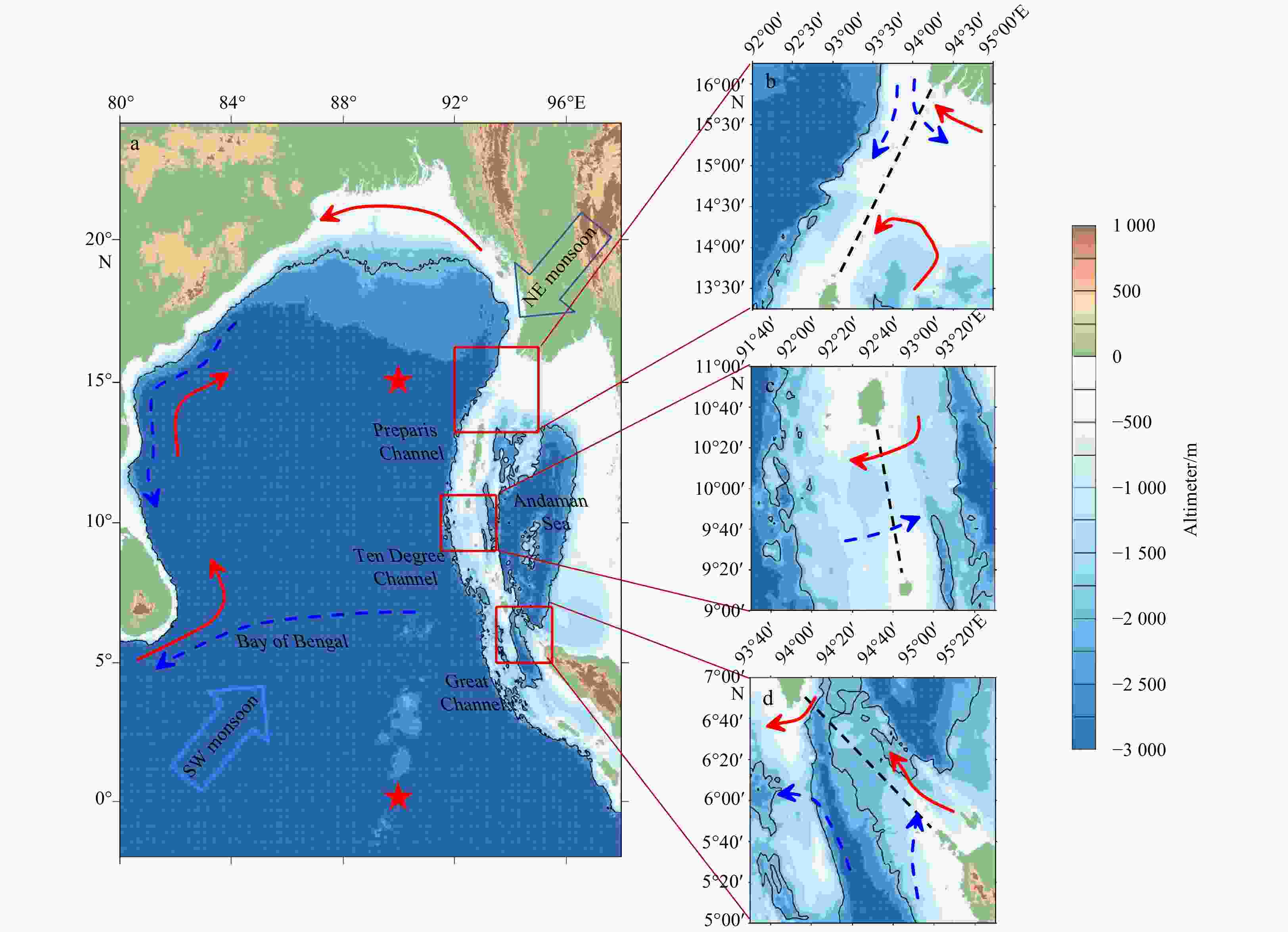
 下载:
下载:
